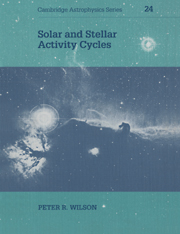Book contents
- Frontmatter
- Contents
- Preface
- Acknowledgments
- 1 Introduction
- 2 Historical survey
- 3 The structure of the Sun and the phenomena of activity
- 4 The equations of magnetohydrodynamics and magnetohydrostatics
- 5 The one-dimensional configuration of the cycle
- 6 Heuristic models of the solar activity cycle
- 7 Stellar activity and activity cycles
- 8 The two-dimensional representation of the extended activity cycle
- 9 The origin of the large-scale fields
- 10 The reversal of the polar magnetic fields
- 11 The role of dynamo theory in cyclic activity
- 12 Helioseismology and the solar cycle
- 13 Cyclic activity and chaos
- 14 Forecasting the solar cycle
- 15 Summary and conclusions
- Author index
- Subject index
7 - Stellar activity and activity cycles
Published online by Cambridge University Press: 27 October 2009
- Frontmatter
- Contents
- Preface
- Acknowledgments
- 1 Introduction
- 2 Historical survey
- 3 The structure of the Sun and the phenomena of activity
- 4 The equations of magnetohydrodynamics and magnetohydrostatics
- 5 The one-dimensional configuration of the cycle
- 6 Heuristic models of the solar activity cycle
- 7 Stellar activity and activity cycles
- 8 The two-dimensional representation of the extended activity cycle
- 9 The origin of the large-scale fields
- 10 The reversal of the polar magnetic fields
- 11 The role of dynamo theory in cyclic activity
- 12 Helioseismology and the solar cycle
- 13 Cyclic activity and chaos
- 14 Forecasting the solar cycle
- 15 Summary and conclusions
- Author index
- Subject index
Summary
Scintillate, scintillate, globule vivivic
Fain would I fathom thy nature specific.
Variation on a well-known themeThe solar-stellar connection
Hale's conviction that solar physics is an essential component of astrophysics was shared by some, but unfortunately not by all, astrophysicists. Nevertheless, a further important initiative in this spirit was taken at Mount Wilson in 1966, when, using the 100-inch Hooker telescope, Olin Wilson and his colleagues began a long-term study of 91 cool dwarf stars (Wilson 1978). In 1978 this project (the ‘HK Project’) was transferred to the Mount Wilson 60-inch telescope, which was dedicated entirely to the continuation and extension of this work and has become identified with a particular methodology known as the solar-stellar connection.
Although the Sun permits the detailed two-dimensional study of its activity phenomena, it exhibits only a single set of stellar parameters, since its mass, size, composition, and state of evolution are necessarily fixed at this point of time. On the other hand, stars, as observed from earth, are essentially one-dimensional objects, but they offer a wide range of physical parameters which permit a more thorough testing of theories and conjectures regarding common phenomena than is possible for the Sun alone. The solar-stellar connection aims to bring these two lines of investigation together in order to further our understanding of the properties of the Sun and other late-type stars.
Even before the solar-stellar connection methodology became recognized as such, there were many examples of the successful application of solar results to stellar investigations.
- Type
- Chapter
- Information
- Solar and Stellar Activity Cycles , pp. 97 - 121Publisher: Cambridge University PressPrint publication year: 1994
- 1
- Cited by



